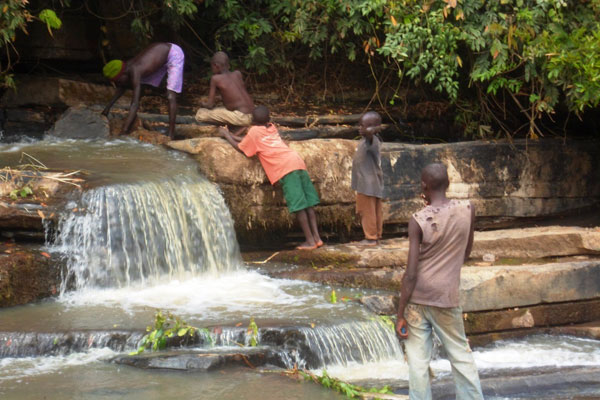West Nile uncovers tourism potential, tasks govt to act

Children at Miriadua Water Falls in Maracha District. The falls, which had been abandoned, now attracts regular visitors. PHOTO | ROBERT ATIKU
What you need to know:
- As part of the efforts, some businessmen and local governments have revived visits to the historical sites.
West Nile’s tourism potential remains untapped over the years, with government and local leaders doing little to improve the sector, Daily Monitor has established.
The available sites are in a dilapidated state with poor road connections and no signposts to direct tourists.
Some of the potential sites include rivers Enyau, Ala, Ora, and Kochi, which drain into River Nile in the east. Numerous streams, mountains, waterfalls and heritage sites such as Salia Musala, the tripartite point where one gets to be in three countries at the same time.
Others are historical sites such as Wang Lei on River Nile, where Gipir and Labongo, the Luo ancestors separated, and Puvungu, the arrival place for the two brothers.
Other sites include Ombaci, a site where soldiers of the Uganda National Liberation Army massacred about 100 people, who had taken refuge at the residence of the Verona Fathers on June 24,1981, after the overthrow of Idi Amin.
Got Nebbi is also another historical site that served as a waiting area for slave traders and Nduru lodge, among others.
According to the Annual Tourism Sector Performance Report for Financial Year 2018/2019, Uganda earned $1.6b (about Shs5.8 trillion) from tourism, which remains the country’s key foreign exchange earner. However, on a number of forums, leaders have committed to developing the sites in vain.
The Arua District chairperson, Mr Sam Nyakua, blames the lack of commitment to develop the sites on limited funding.
“The private sector can reap big from the tourism sites once they are revived,” he said. Mr Nyakua said the revival would be made possible through advertising, grading of the roads and construction of better hotels.
“Tourism is one potential area where the districts could generate income to expand its revenue base, use for research and study purpose. As part of the efforts, some businessmen and Maracha District local government have now revived visits to Miradua Falls and Alikua Pyramid and Wang Lei,” he said.
Mr Joseph Wambuzi, the executive director for Oasis 24/7 and Bamboo Village Hotels, said the tourism sector needs professionals in the hotel industry to handle tourists.
“Government needs to decentralise tourism sites and hospitality institutions in the region. If roads, social amenities leading to these places are done, hotel owners would also reap more income from them. We need the sites to be revived to scale up business,” he said.
Mr Gerald Iga, a tour guide in Arua, on Tuesday said: “Tourism in this region is still virgin because most of the sites were abandoned long ago. There is need to revive them so that we can tap into their tourism potential.”
An elder in Arua Town, Mr Jaffar Alekua, said the political turmoil and lawlessness that prevailed in the 1980s did not spare the tourist sites. “As elders, we are trying to lobby friends and districts to revive these sites. They are historical both for our grandchildren and for research purpose,” he said.
The region also lacks professional travel agents and tour firms that could spur the tourism industry.
For instance, Ajai Game Reserve was initially gazetted as a White Rhino sanctuary in 1937, but it has remained redundant as most animals were poached.
In 2006, two white rhinos were brought into Uganda from Disney Animal Kingdom in the US state of Florida.
The Uganda Wildlife Authority did not transfer some of the rhinos at Zziwa Ranch in Nakasongola to Ajai Game Reserve because the area is still insecure.
Natural historical sites
- Got Nebbi, the waiting/rest area for slave traders and Nduru lodge
- Wang Lei on River Nile, where Gipir and Labongo separated
- Puvungu, the first place of arrival of the 2 brothers Gipir and Labongo
- Biku in Goli in Nebbi District, the smallest church in the world
- Traditional Alur regalia like Babla (wooden saddles)
- The Albert Nile, Obua and Miriadua falls, Liru and Mountain Wati where the traditional stony chairs still lie.
- l Rivers Enyau, Ala, Ora, and Kochi, which drain into the Nile in the east and also numerous streams. The Ombaci massacre site
- Fort Dufile of Emin Pasha in Moyo, Gordon Hills on Moyo-Sudan border, Alikua Pyramids in Maracha, Lake Adola Milan in Koboko, Pavungu area in Nebbi District and Indriani, the site of the first missionary church in Adjumani District.




